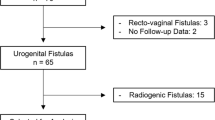Abstract
Introduction and hypothesis
The urogenital fistula is a devastating condition for women. Despite advances in medical care, the vesicovaginal fistula continues to be a distressful problem. Complex vesicovaginal fistulae repair may need tissue interposition. It can be achieved by vaginal or abdominal approach and depends on the surgeon's experience and local factors like size, location, and previous radiotherapy. The aim of this study was to demonstrate that using traditional approaches is possible and reasonable to treat any sort of vesicovaginal fistula.
Methods
Between January 2004 and August 2007, we treated 23 patients with complex urogenital fistulae. Of those with concomitant ureteral fistula requiring re-implantation or bladder augmentation, the vaginal approach was the first choice in 17 and abdominal approach in six. Patients were clinically evaluated at 1, 4, and 12 weeks postoperatively, then every 3 months in the first year.
Results
Seventeen women were treated by vaginal approach and six patients were treated by abdominal approach. Hysterectomy was the major etiology (73.9%). Ten patients (43.5%) had at least one previous abdominal surgery for fistulae repair without success before. In those patients with abdominal approach, the hospitalization was longer than vaginal approach (80.5+/−6 h versus 48+/−3 h). In both, there were no major intraoperative or postoperative complications; 13% developed urgency and 4% developed stress urinary incontinence. No patients have recurrence of fistulae (success rate 100%).
Conclusions
Complex vesicovaginal fistulas are a big challenge for the urologist, and there is no gold standard surgical approach. The majority of complex vaginal fistula can be successfully managed by vaginal repair. As the vaginal approach is a minimally invasive procedure with low costs, easy learning curve, and high cure rates, new approaches must be carefully evaluated before being suggested as an alternative.




Similar content being viewed by others
Abbreviations
- VVF:
-
Vesicovaginal fistula
- VCUG:
-
Voiding cystouretrography
- IVU:
-
Intravenous urography
- USG:
-
Ultrasonography
References
Derry DE (1935) Note on five pelves of women of the eleventh dynasty in Egypt. J Obstet Gynaecol Br Emp 42:490–493
Mattingly RF, Thompson JD (1985) Te Linde’s operative gynecology. J.B. Lippincott, Philadelphia, Philadelphia
Davits RJ, Miranda SI (1991) Conservative treatment of vesicovaginal fistulas by bladder drainage alone. Br J Urol 68:155–156
Stovski MD, Ignatoff JM, Blum MD, Nanninga JB, O’Connor VJ, Kursh ED (1994) Use of eletrocoagulation in the treatment of vesicovaginal fistulas. J Urol 152:1443–1444
Hemal AK, Kolla SB, Wandhwa P (2008) Robotic reconstruction for recent supra-trigonal vesicovaginal fistulas. J Urol 180:981–985
Cohen BL, Gousse AE (2007) Current techniques or vesicovaginal fistulas repair: surgical pearls to optimize cure rate. Curr Urol Rep 8:413–418
Eilber KS, Kavaler E, Rodríguez LV, Rosenblum N, Raz S (2003) Ten-year experience with transvaginal vesicovaginal fistula repair using tissue interposition. J Urol 169:1033–1036
Raz S (2002) Atlas of transvaginal surgery. WB Saunders, Philadelphia
O’Connor VJ, Sokol JK, Bulkley GJ, Nanninga JB (1973) Suprapubic closure of vesicovaginal fistula. J Urol 109:51–54
Creanga AA, Ahmed S, Genadry RR, Stanton C (2007) Prevention and treatment of obstetric fistula: identifying research needs and public health priorities. Int J Gynecol and Obstet 99:141–154
Elkins TE (1994) Surgery for the obstetric vesicovaginal fistula: a review of 100 operation in 82 patients. Am J Obstet Gynecol 170:1118–1120
Blandy JP, Badenoch DF, Fowler CG, Jenkins BJ, Thomas NW (1991) Early repair of iatrogenic injury to the ureter or bladder after gycecological surgery. J Urol 146:761–765
Blaivas JG, Heritz DM, Romanzi LJ (1995) Early versus late repair of vesicovaginal fistulas: vaginal and abdominal approaches. J Urol 153:1110–1112
Eilber KS, Rosenblum N, Rodriguez LV (2005) Female urology, urogynecology and voiding dysfunction. Marcel Dekker, New York
Nesrallah LJ, Srougi M, Gittes RF (1999) The O’Connor technique: the gold standard for supratrigonal vesicovaginal fistulas repair. J Urol 165:566–568
Nezhat CH, Nezhat F, Nezhat C, Rottenberg H (1994) Laparoscopic repair of vesicovaginal fistula: a case report. Obstet Gynecol 83:899
Myklos JR, Sobolewski C, Lucente VR (1999) Laparoscopic management of recurrent vesicovaginal fistula. Int Urogynecol J Pelvic Floor Dysfunct 10:116
Melamud O, Eichel L, Turbow B, Shanberg A (2005) Laparoscopic vesicovaginal fistula repair with robotic reconstruction. Urology 65:163
Sundaram BM, Kalidasan G, Hemal AK (2006) Robotic repair of vesicovaginal fistula: case series of 5 patients. Urology 67:970
Conflicts of interest
None
Author information
Authors and Affiliations
Corresponding author
Rights and permissions
About this article
Cite this article
Zambon, J.P., Batezini, N.S.S., Pinto, E.R.S. et al. Do we need new surgical techniques to repair vesico-vaginal fistulas?. Int Urogynecol J 21, 337–342 (2010). https://doi.org/10.1007/s00192-009-1040-5
Received:
Accepted:
Published:
Issue Date:
DOI: https://doi.org/10.1007/s00192-009-1040-5




